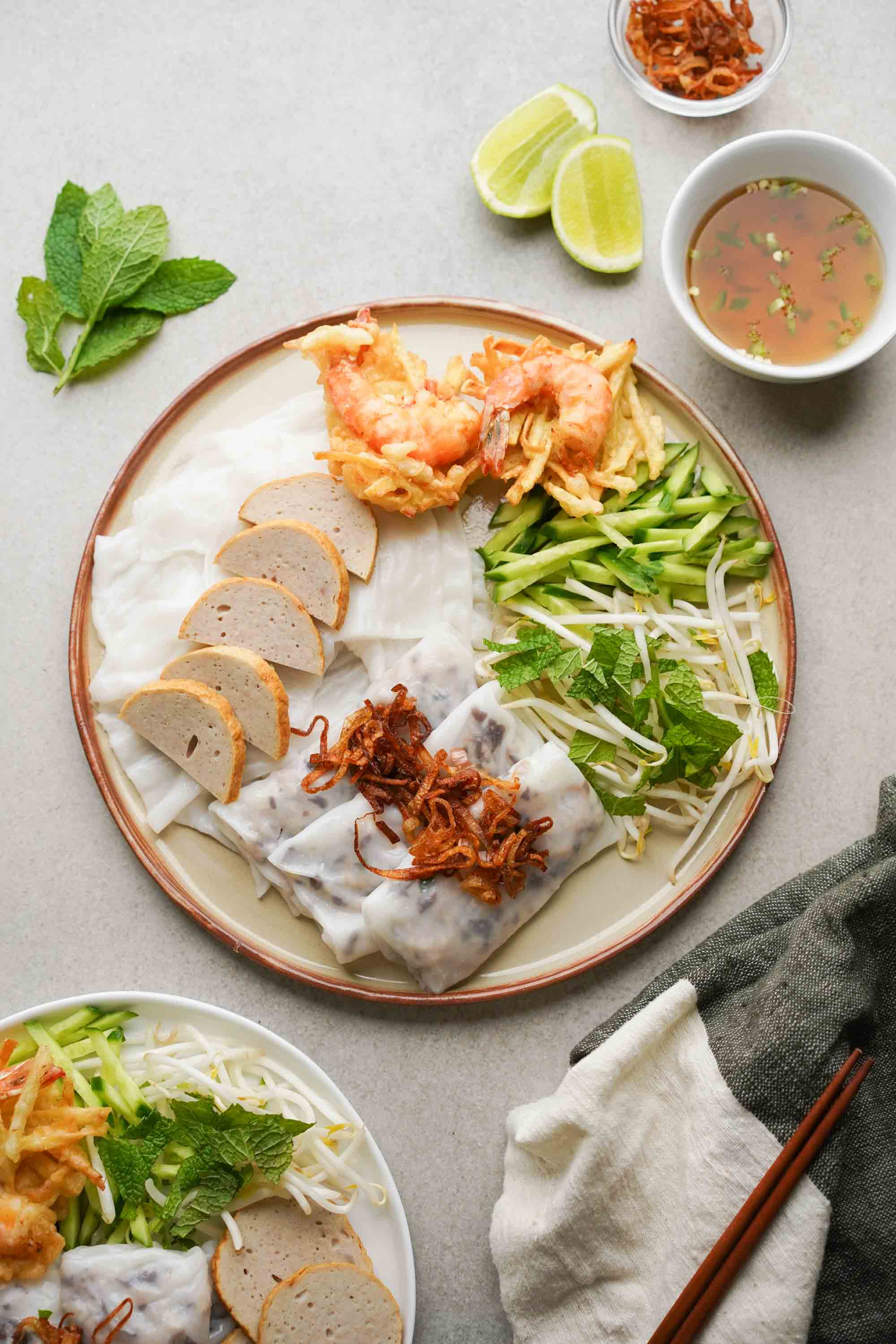
Bánh Cuốn / Bánh Ướt Recipe (Vietnamese Rice Rolls)

Bánh cuốn alwats gets me more EXCITED than anyone I know. Trust me there’s something really fun about polishing a plate of these.
Perhaps its the little individual rolls and unlimited combination of sides you can do that make each bite fun to craft and slightly different from the last. But any way you combine them it’s delicious for sure.
Nothing beats the freshly steamed rice wrappers-they have a warmth and delicate chew you want to enjoy quickly. The filling of pork and veggies gives a burst of flavor. You’ll always find a fresh mound of bean sprouts, herbs and other sides, all meant to be dipped or drizzled in a prepared fish sauce.
So like any freshly baked or steamed cake, due to its fleeting freshness window, these are best enjoyed fresh off the steamer, and nothing cuts that window down like homemade bánh cuốn. And at home you can tailor the filling, sides, and dipping sauce just how you want. Read on to learn how my favorite way to eat these.
What is bánh cuốn?
The name literally means rolled cakes because these delicious little treats are a batter of primarily rice flour, and the traditional filling is made of pork, onion, jicama, and mushrooms which are then rolled up.
The key word is “rolled” here since the Vietnamese word for “bánh” is very fluid and difficult to directly translate. It applies to baked goods, sweets, savory foods, but is literally applied to any food item that contains some type of flour.
Some places like to wrap other fillings in it too, like ground shrimp or less common ones like grilled pork or even eggs. But any place that sells these rolls, also sells the plain, no-filling version too called banh uot, or wet cakes.
Rice flour for bánh cuốn batter: 3 ways
I’ve helped mom prepare this dish many times at her house when growing up and when visiting. It’s always quite an involved looking production and it’s fun to steam! It wasn’t until recently that I really wanted to learn the recipe and narrow it down to something simpler.
This batter is the difficult part of this recipe. It is the core that carries the dish, and if you’re not adding any filling it is literally everything. I worked with mom over many variations and trials here to find one we loved. She’s been making bánh cuốn for decades but still wasn’t happy enough with the results to want to share, until now.
There are three main options for making bánh cuốn batter at home, each with their advantages and disadvantages. The focal point is around the rice flour:
- Pre-mixed bánh cuốn flour.
- Using pre-ground rice flour.
- Milling / grinding your own rice flour.
Narrowing down the recipe for the batter is a matter of structural integrity and personal preference. You need enough rice flour to make up the bulk of the rice paper, but we want tapioca flour for chew or elasticity. If the batter isn’t flexible enough, it will break when you try to lift it on the steamer. If you increase the ratio of tapioca flour too high, it can become super mushy or sticky.
Pre-mixed, store-bought flour is the easiest option. It has everything you need to make the batter, you just need to add water. My mom claims that no one but the pickiest cooks have been able to tell it’s any less than making your own mix at home. If you have access to a local market where prices are substantially cheaper, Vinh Thuan is the only brand we tested and liked. Otherwise you can get it online too.
The 2nd easiest option is to use store-bought rice flour. This way you don’t have to go through the trouble of buying, soaking, and milling or grinding your own rice.
Milling or grinding your own rice is more work. BUT it gives you a chance to use up long grain rice you have in the house-this is the main reason to do it since you want to use older / aged rice which isn’t as good for cooking to eat with your meals. Basmati rice is prized for great results, but any long grain rice works well for this. The older rice gives preferable results for milling into flour for bánh cuốn though.
Grinding or milling your own rice flour means you’ll have better results in the batter, meaning the bánh cuốn achieves a desirable level of softness and chewyness. My mom is ultra picky about the batter, and she likes to do that process, so it’s worth it. This process of milling rice flour for bánh cuốn is actually one she learned from her grandma (my great grandmother).
Soaking the rice flour before use
Whether you buy store mix or make your own flour, you’re going to need to soak the rice grains or rice flour.
The goal of soaking is threefold: to make the final steamed rice cakes softer, clearer in apperance once cooked, and to remove a certain rice smell that seems to only be removed by soaking. This smell is subtle and one you can only detect after steaming the rice cake.
To soak, add the flour to a large bowl, and enough water to cover + a few inches. Then a few hours after the flour has settled, scoop out as much water as you can without disturbing the flour, and replace it with the same amount you discarded.
The good news is that, if you don’t want to mill your own rice flour, soaking rice flour in water for two days will get you comparable final results with 2-3 changes of water in between.
If you’re new to making bánh cuốn though, you can just stick with pre-milled rice flour for simplicty.
Extra tips for soaking flour (do not bother on your first try):
If you soak the rice flour for two nights with multiple rinses in between, it gets soft enough that you won’t even need tapioca or potato starch.
And if you want to cut down on soaking time even more, use rice starch instead of rice flour. Instead of soaking rice flour for a total of two days, the soak time for rice starch is only about 8 hours for good results with only one change of water.
Cooking on a bánh cuốn steamer vs frying pan
Bánh cuốn batter can be made on a specialized bánh cuốn steamer, or on a regular frying pan.
For better results, you want to steam your bánh cuốn. This method gets rid of the raw rice taste which makes it much more appetizing than doing it in the pan. Luckily many Asian and Vietnamese supemarkets and restaurant supply stores now carry steamers specifically designed to make bánh cuốn.
The recipe below is not designed for cooking in a pan, so you may have to tweak flour ratios or how much water is in it for you to be able to cook it in a pan.
Where can you buy a bánh cuốn steamer?
A lot of people make this steamer nowadays with lots of tutorials online. It’s convenient to just buy the premade one if you have stores nearby. Chinese and Vietnamese restaurant supply stores may stock this. They can run about $40 for the average steamer.
You may benefit from making your own steamer if you want to save money, running you about $12 total, and you can just attach this to existing pots you have. People will tend to attach fabrics with elastics or laces, and if you want to get fancy it can be the metal tightening rings that won’t lose the holding strength over time.
The primary goal is to have the fabric pulled really tight. The tighter the fabric, the thinner you can pour the batter, which results in better banh cuon.
Before this local availability, my parents made this steamer themselves, by stretching a piece of fabric around a ring and fixing it to a pan with a tightening metal clamp-it was quite crafty of them. But it was either this, or have someone bring a steamer back from Vietnam for you!
You need a stick to remove the steamed rice cakes too. Using a long offset cake spatula works great for this too if you don’t have a skinny bamboo one.
How to store bánh cuốn batter
Batter stays fresh up to 7-10 days in the fridge if you keep it clean and in the fridge. After the intial soaking with water changes, you don’t need to do more water changes for batter texture. However if you have a large amount of refrigerated / cold water, we can still exchange much of this water with new, room temp water, so its easier to stir up the cold flour. We need to stir the batter to make sure its fully incorporated before pouring each ladle onto the steamer.
If you actually end up storing the batter for this long in the fridge, the final texture will become more soft, so you may need to add a few tablespoons of rice flour to this ‘old’ batter so you can properly pour the batter.
Usually it’s not worth storing the batter because cleaning everything is a lot of labor-you’re better off cooking everything in one session and cleaning up only once.
Bánh cuốn filling
For this recipe, we’re going with a traditional mixture for the filling. Nowadays since meat is less scarce, you may see variations with more meat. You can also change it up to be almost all meat if you like, but this original recipe tastes good. In Hue variations you can find dried shrimp or fresh ground shrimp filling too!
Pork is omnipresent in Vietnamese cuisine, and it tastes good with this dish. The chosen veggies provide a nice balance of crunchy texture, aroma from the onions, and the veggies provide sweetness too, so you don’t need to add sugar to it.
But again, we’re going to stick with the traditional filling for this recipe-you’re gonna love it!
Garnishes and sides for bánh cuốn
Part of what makes bánh cuốn (and many other Vietnamese entrees) look so grand is the mountain of veggies and herbs on top. And I welcome it.
Bánh cuốn herbs and raw veg can vary a little from place to place but the way I PERSONALLY love to serve it is with these on top or on the side:
- Crunchy cucumber - like Persian or English, sliced into short matchsticks or thin rounds
- Bean sprouts - I prefer these blanched so they’re more flexible but still have a little crunch. It’s the same way I like my bean sprouts for phở too.
- Fried shallots - the same way you’d make fried garlic
- Herbs - the must have ones are Thai basil and mint but I also love rau ram
Where can you buy bánh cuốn?
At the endless options of shops we have here in Souther California’s Little Saigon, you will find bánh cuốn at just about every grab and go food shop. Banh mi shops like Banh Mi Che Cali, or THH sell ready-to-eat single serving plates of these. Some even offer catering tray sizes you can order.
I’m also lucky to have SO many bánh cuốn restaurants nearby. Some of my favorite spots to go out for banh cuon locally are:
- Banh Cuon Luu Luyen
- Bah Cuon Thanh Tri
- Banh Cuon Tay Ho
- THH
And of course some supermarkets will have the same plastic wrapped lunch plates of these near the checkout registers. These same supermarkets will also have a whole aisle dedicated to flours and premixed batters for favorite flour-based Vietnamese recipes like bánh xèo, Vietnamese curry, pandan waffles, bánh bèo, and more.
Link nội dung: https://blog24hvn.com/banh-cuon-a38522.html